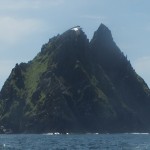Unraveling the History of Skellig Michael
Skellig Michael is an island shrouded in mystery and folklore from early history. The earliest reference of the skelligs is in legend of course, with the drowning of Ir during the landing of the milesians, the first Gaelic conquerors of Ireland. Ir was said to be buried on the rock. There is also reference to Daire Domhain, the “King of the world”, who is meant to have made the skelligs a base while he was gathering his troops, before entering the “great battle” with Fionn MacCool at Ventry on the Dingle Peninsula. Another fascinating reference in legend features Skellig Michael to be the place that Arch Angel Michael arrived before helping St Patrick banish the snakes from our lands.



Ancient Histories
There are many references throughout the Irish annals suggesting that the skelligs is a place of refuge and retreat. These references date as far back as the 5th century. The modern opinion is that the skellig rock was a monastic settlement founded by St. Finan. However, there are some that believe that the settlement was founded by St. Subhine, as the architecture of the island would imply that it is in existence from the 6th century on. So what is the true date of the settlement? The general consensus by the experts is that the settlement has its origin in the 7th century.
When the monks left
It is considered to be in the 13th century that the monks left the island for the mainland. Ballinskelligs was their chosen destination, as there was a monastery in the area. The reason for the move is believed to be the climate change or the general change in monastic practices.
What happened to Skellig Michael then?
It is believed that the rock had exchanged several private hands before the state stepped in and purchased it. Today the island is owned by the state, except for the lighthouse area, which is under the jurisdiction of the Ministry of the Environment, Heritage and Local Government.
A place of pilgrimage
The rock is believed to be a place of pilgrimage since the 16th century. According to an article by Sean Adcock, professional member of Dry Stone Walling Association, pilgrimage is described as the following:
“In 1756 Charles Smith in the History of Kerry described the pilgrimage, part of which traditionally involved a climb beyond the monastic site itself right up to the upper terrace of the hermitage. Ascending beyond the monastery pilgrims would at one point squeeze through a shaft known as the ‘Needles Eye’; later over 12 feet of sloping smooth rock aka the ‘Stone of Pain’ – due to the difficulty of crossing eased by a few scant cut hand and foot holds. Beyond this there are 2 stations to visit with stone crosses. The first is the ‘Eagles Nest’. The second, which is more inaccessible, is the ‘Spindle’ or ‘Spit’: a long narrow fragment of rock projecting from the summit of this frightful place over a raging sea: and this is walked to by a narrow path of only two feet in breadth and several steps in length. Here the devotees… sit astride this rock and so edge forward until they arrive at a stone cross which some bold adventurer cut formerly on its extreme end… (P.Logan, “The Holy wells of Ireland”).
Stay tuned
I hope you enjoyed this article this week on the great rock. Please feel free to like and share our posts. Also make sure you keep touching base with us as there will be much more posts on the island in the coming weeks and months. If you are coming to Ireland, you simply have to come with us at Skellig Michael Cruises to experience firsthand this breathtaking historical site.








